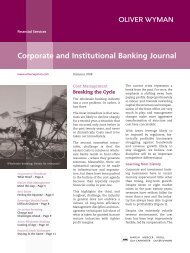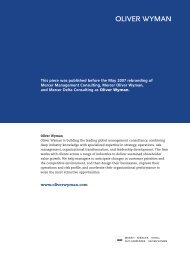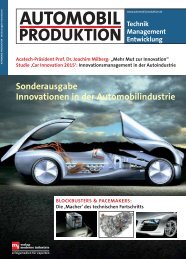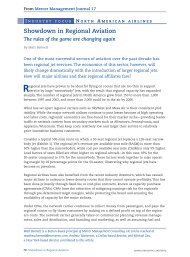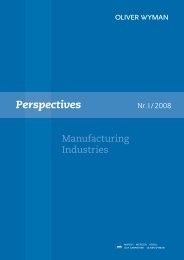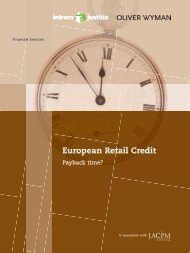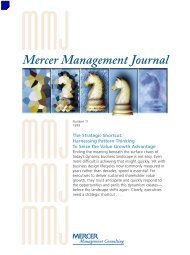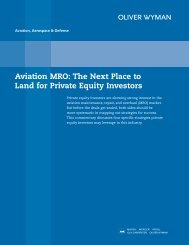This piece was published before the May 2007 ... - Oliver Wyman
This piece was published before the May 2007 ... - Oliver Wyman
This piece was published before the May 2007 ... - Oliver Wyman
Create successful ePaper yourself
Turn your PDF publications into a flip-book with our unique Google optimized e-Paper software.
<strong>This</strong> <strong>piece</strong> <strong>was</strong> <strong>published</strong> <strong>before</strong> <strong>the</strong> <strong>May</strong> <strong>2007</strong> rebranding of<br />
Mercer Management Consulting, Mercer <strong>Oliver</strong> <strong>Wyman</strong>,<br />
and Mercer Delta Consulting as <strong>Oliver</strong> <strong>Wyman</strong>.<br />
<strong>Oliver</strong> <strong>Wyman</strong><br />
<strong>Oliver</strong> <strong>Wyman</strong> is building <strong>the</strong> leading global management consultancy, combining<br />
deep industry knowledge with specialized expertise in strategy, operations, risk<br />
management, organizational transformation, and leadership development. The firm<br />
works with clients across a range of industries to deliver sustained shareholder<br />
value growth. We help managers to anticipate changes in customer priorities and<br />
<strong>the</strong> competitive environment, and <strong>the</strong>n design <strong>the</strong>ir businesses, improve <strong>the</strong>ir<br />
operations and risk profile, and accelerate <strong>the</strong>ir organizational performance to<br />
seize <strong>the</strong> most attractive opportunities.<br />
www.oliverwyman.com
Breaking <strong>the</strong> Yield Barrier<br />
How airlines can create new revenue streams by<br />
merchandising ancillary goods and services<br />
By Andrew Watterson and Raj Lalsare<br />
Airline passengers represent a huge potential market for food, insurance,<br />
package tours, and o<strong>the</strong>r products that are adjacent to <strong>the</strong> core product of a<br />
seat in an aircraft. Carriers in search of high-margin growth can cultivate this<br />
market by building awareness, generating traffic, closing transactions, and filling<br />
<strong>the</strong> “shopping basket”––in short, by learning how to think like a retailer.<br />
Despite recent successes in raising fares,<br />
<strong>the</strong> airline industry continues to experience<br />
long-term price deflation on its primary<br />
product: a seat on an airplane. It has proved<br />
difficult for airlines to break through this<br />
“yield barrier” to increase revenues (Exhibit 1).<br />
The problem is that for most customers air<br />
travel has become a commodity based primarily<br />
on ticket price and a convenient flight.<br />
Some airlines, such as Virgin Atlantic, have<br />
tried to offer a different travel experience,<br />
Exhibit 1 The long-term decline of airline yields<br />
Index:<br />
1985=100<br />
190<br />
170<br />
150<br />
130<br />
110<br />
100<br />
90<br />
1985 '87 '89 '91 '93 ‘95 '97 '99 '01 '03 ‘05<br />
Source: Air Transport Association<br />
Note: Yield is defined as <strong>the</strong> average revenue from sold seat-miles;<br />
real yield adjusted to 1985 dollars.<br />
CPI<br />
Real yield<br />
and some customers seem willing to pay a bit<br />
more for that. For most o<strong>the</strong>r airlines, however,<br />
yield and <strong>the</strong> profitability of a ticket will<br />
continue to decline.<br />
Over <strong>the</strong> past five years, airlines have<br />
aggressively reduced costs only to see soaring<br />
fuel prices eat away much of <strong>the</strong>ir savings.<br />
Even Southwest Airlines, which has one of <strong>the</strong><br />
lowest cost structures in <strong>the</strong> business, realizes<br />
that revenues have to grow and raised its top<br />
fares in March and July of 2006. <strong>This</strong> is a sure<br />
sign that cost reduction, while imperative, is<br />
not sufficient to achieve financial stability.<br />
All industries face <strong>the</strong> threat of commoditization<br />
of <strong>the</strong>ir core products at one point or<br />
ano<strong>the</strong>r. Demand curves shift and drive innovation<br />
for better products and services.<br />
Pharmaceutical firms, for example, confront<br />
<strong>the</strong> challenge by developing derivatives of<br />
existing drugs or drugs for adjacent disease<br />
areas.The good news is that, as in o<strong>the</strong>r industries,<br />
airlines can achieve new levels of growth<br />
by addressing customer demand that is adjacent<br />
to <strong>the</strong> core product of an airplane seat.<br />
When purchasing <strong>the</strong>ir tickets, Internetenabled<br />
passengers are notoriously adept at<br />
finding <strong>the</strong> lowest price. But once travel has<br />
begun, passengers may be far more willing to<br />
trade price for convenience, just as people<br />
who buy a 2-liter bottle of soda at a discount<br />
retailer for 99 cents will pay <strong>the</strong> same price<br />
Andrew Watterson is a Dallas-based director and Raj Lalsare is a Dallas-based senior associate of<br />
Mercer Management Consulting. They can be reached at andrew.watterson@mercermc.com, and<br />
raj.lalsare@mercermc.com.<br />
52 Breaking <strong>the</strong> Yield Barrier<br />
Mercer Management Journal
for a .35-liter can at a vending machine.<br />
Several industries have been particularly<br />
adept at capitalizing on customers’ different<br />
demand elasticities for different purchase<br />
occasions. Gas stations are a well-known<br />
example. In a perpetual price war for <strong>the</strong>ir<br />
basic product of fuel, <strong>the</strong>y looked for new<br />
sources of revenue and profits and began<br />
offering food, beverages, tobacco, and o<strong>the</strong>r<br />
items that didn’t warrant a trip to <strong>the</strong> supermarket<br />
and could easily be combined with a<br />
fill-up. Hence <strong>the</strong> term “convenience store.” A<br />
decade ago, non-fuel sales contributed less<br />
than one-fifth of <strong>the</strong> gross margin at gas stations,<br />
whereas today almost half of <strong>the</strong> gross<br />
margin comes from non-fuel sales, according<br />
to <strong>the</strong> National Association of Convenience<br />
Stores. British Petroleum, after merging with<br />
Amoco in 1998, embarked on a major marketing<br />
campaign to re-brand itself and<br />
remodel its gas stations into a welcoming<br />
place under <strong>the</strong> slogan “beyond petroleum.”<br />
In <strong>the</strong> movie <strong>the</strong>ater business, over 90% of<br />
profits now come from concession stands and<br />
advertising. The average movie ticket in <strong>the</strong><br />
U.S. costs about $6.50, while in most <strong>the</strong>aters,<br />
a medium-size drink and bag of popcorn cost<br />
$7.50. Two major <strong>the</strong>ater chains, AMC and<br />
Regal Cinemas, report that <strong>the</strong>y barely break<br />
even on movies; it is <strong>the</strong> ancillary products<br />
that contribute to <strong>the</strong> movie experience and<br />
keep <strong>the</strong>m in business.<br />
Many hotels, casinos, and <strong>the</strong>me parks have<br />
also dealt with <strong>the</strong> commoditization of <strong>the</strong>ir<br />
core product by cultivating adjacent demand.<br />
Host Hotels and Resorts, for instance, reported<br />
that 38% of its revenue for <strong>the</strong> first quarter of<br />
2006 came from non-room sources. In Las<br />
Vegas, casinos have added 3 million square<br />
feet of new retail space over <strong>the</strong> past five<br />
years, with many of <strong>the</strong>se shops, restaurants,<br />
and spas becoming some of <strong>the</strong> most profitable<br />
retail real estate in <strong>the</strong> country.<br />
The European Experience<br />
Among airlines, it is <strong>the</strong> innovative carriers<br />
in Europe that are leading <strong>the</strong> way in capturing<br />
high-margin revenue from adjacent<br />
demand. For instance, easyJet’s 2006 earnings<br />
forecast projects that passenger revenues per<br />
seat will grow between 3% and 4%, driven<br />
largely by ancillary revenues, which are projected<br />
to grow 30%.<br />
European low-cost carriers have developed<br />
three types of non-transport revenue models:<br />
Partnership deals, in which co-branded<br />
partners market <strong>the</strong>ir services and products<br />
across <strong>the</strong> carriers’ travel chain as if<br />
it were a real estate property or a marketing<br />
channel. These carriers have cultivated<br />
strong brands in order to draw<br />
customers directly to <strong>the</strong>ir websites, and<br />
partners have been willing to pay for <strong>the</strong><br />
brand association and channel leverage.<br />
Ryanair markets packages for events such<br />
as <strong>the</strong> Grand Prix and wine-tasting tours.<br />
EasyJet markets car rentals for Europcar,<br />
ski packages for several resorts, lodging<br />
for many hotel chains, and has even cobranded<br />
air sickness bags on board with<br />
photo developer Klick Photopoint.<br />
Retail sales, where <strong>the</strong> carriers sell add-ons<br />
such as trip insurance and in-flight food,<br />
beverages, and merchandise. Here again,<br />
easyJet has been aggressive, co-marketing<br />
lounges on a per-use basis with Servisair<br />
operators at select airports. Via easyJet’s<br />
website, customers can purchase entry to<br />
use in conjunction with <strong>the</strong>ir trips.<br />
Service fees and penalties related to luggage,<br />
seat assignment, and o<strong>the</strong>r aspects of<br />
travel. Flybe, which has a rapidly<br />
expanding network of European and<br />
domestic flights from regional U.K. airports,<br />
has been charging customers £4 a bag per<br />
one-way flight for checked-in luggage since<br />
February, 2006. The fee drops to £2 if customers<br />
pay via <strong>the</strong> website up to two<br />
hours <strong>before</strong> <strong>the</strong> flight departs. O<strong>the</strong>r U.K.<br />
airlines are charging extra for an exit row<br />
seating assignment. To be sure, <strong>the</strong>re is an<br />
implicit risk in charging customers for<br />
something <strong>the</strong>y may perceive as part of<br />
<strong>the</strong>ir travel purchase; none<strong>the</strong>less, service<br />
fees are a new source of revenue.<br />
Mercer Management Journal<br />
Breaking <strong>the</strong> Yield Barrier 53
North American airlines, particularly <strong>the</strong><br />
legacy hub-and-spoke carriers, have been<br />
slower to harvest adjacent demand. Most of<br />
U.S. carriers’ non-ticket revenue comes from<br />
loyalty-program-related partnerships, and is<br />
stagnating, while most of <strong>the</strong> European lowcost<br />
carriers’ non-ticket revenue is generated<br />
via retail sales and brand partnerships, and is<br />
growing rapidly (Exhibit 2 ).<br />
The U.S. carriers’ experience in this area has<br />
emerged primarily through frequent flyer programs,<br />
which <strong>the</strong>y have monetized through<br />
partnership deals and consumer product<br />
selections. In 2005, Air Canada raised $200 million<br />
by selling 12.5% of its loyalty program,<br />
Aeroplan, into an income trust; this implied a<br />
total valuation of $1.6 billion for Aeroplan.<br />
The top three North American airlines<br />
derived 8% to 10% of <strong>the</strong>ir 2005 revenue from<br />
non-transport sources, mostly business partnerships.<br />
They have also turned to penaltybased<br />
sources of revenue, charging for ticket<br />
changes, excessive baggage weight, or talking<br />
with a reservation agent. However, such<br />
service fees may undermine customer loyalty,<br />
no matter how clear <strong>the</strong> fine print.<br />
At <strong>the</strong> same time, <strong>the</strong>se carriers have been<br />
slow to cultivate o<strong>the</strong>r non-ticket revenues.<br />
They have not made customers aware of <strong>the</strong><br />
few products that do exist, such as buy-onboard<br />
food, and <strong>the</strong>y lack robust transaction<br />
systems at <strong>the</strong> point of sale. As a result, customers<br />
still perceive <strong>the</strong> travel experience as<br />
one, all-inclusive product, which remains a<br />
hurdle to selling add-ons.<br />
As managers at legacy carriers and o<strong>the</strong>r airlines<br />
start to experiment with developing ancillary<br />
revenues, <strong>the</strong>y can benefit by studying<br />
some powerful principles from <strong>the</strong> retail sector.<br />
As we have seen, well-run retailers are adept at<br />
developing products and services around <strong>the</strong>ir<br />
core offerings.<br />
Think Like a Retailer<br />
A retailer’s management of <strong>the</strong> shopper’s<br />
experience and <strong>the</strong> firm’s method of capturing<br />
value can be simplified into five steps<br />
(Exhibit 3):<br />
Build awareness. Retailers spend enormous<br />
resources to build a brand and secure consumers’<br />
attention. Wal-Mart’s entry into groceries<br />
and fresh produce is a great example.<br />
Just a few years ago, Wal-Mart <strong>was</strong> a discount<br />
store. Wal-Mart ran a steady campaign to<br />
create awareness of its Supercenter grocery<br />
concept. Awareness grew in just a few years<br />
as Wal-Mart effectively expanded its “always<br />
Exhibit 2 European low-cost carriers are aggressively growing non-ticket revenues<br />
$15<br />
CAGR<br />
United<br />
3%<br />
Non-ticket<br />
revenue,<br />
$ per<br />
passenger<br />
10<br />
Ryanair<br />
Delta<br />
11%<br />
2%<br />
5<br />
easyJet<br />
15%<br />
0<br />
2000 ‘01 ‘02 ‘03 ‘04 ‘05<br />
Source: Company annual reports, The Airline Monitor<br />
54 Breaking <strong>the</strong> Yield Barrier<br />
Mercer Management Journal
low prices” guarantee to groceries. In many<br />
regions, it has become <strong>the</strong> preferred destination<br />
for grocery and fresh produce shopping.<br />
In selling a seat on an aircraft, airlines promote<br />
<strong>the</strong>ir brands, prices, and sometimes<br />
<strong>the</strong>ir products, so that customer awareness of<br />
travel choices is generally high. Awareness of<br />
new purchase opportunities could be created<br />
for far less money, as <strong>the</strong> target segment has<br />
been reduced to those already planning and<br />
buying travel.<br />
Generate traffic. Based on a perceived need<br />
and brand awareness, consumers come to <strong>the</strong><br />
retailer’s store or website to assess <strong>the</strong> products’<br />
attributes and value. While <strong>the</strong> Internet<br />
may have reinforced <strong>the</strong> commoditization of<br />
many products, including <strong>the</strong> aircraft seat, it<br />
has also generated a lot of traffic to <strong>the</strong> virtual<br />
store window. At Amazon.com,<br />
throughout <strong>the</strong> book browsing and buying<br />
process, customers are informed of related<br />
titles and authors, which increases Amazon’s<br />
chance of making an add-on sale.<br />
For airlines, sales of <strong>the</strong> aircraft seat generate<br />
traffic for <strong>the</strong> ancillary store. Not all<br />
passengers will buy, of course, but as each<br />
passenger goes through <strong>the</strong> travel experience,<br />
he or she is progressively more willing<br />
to pay a premium for certain products. Some<br />
airlines have realized that this dynamic<br />
exists, and <strong>the</strong>ir agents ask at <strong>the</strong> end of <strong>the</strong><br />
reservation process whe<strong>the</strong>r a rental car or<br />
hotel booking is needed. The propensity and<br />
capability to sell ancillary products and services<br />
needs to be embedded in airlines’ entire<br />
value chain.<br />
Create a transaction. Many retailers try to get<br />
consumers to make a purchase through “loss<br />
leader” products or everyday low prices. In<br />
selling seats, airlines and travel resellers have<br />
put a lot of effort into improving <strong>the</strong> “look to<br />
book” ratio, and like retailers, <strong>the</strong>ir tactics<br />
often center on price. For ancillary products<br />
and services, <strong>the</strong>re are several points in <strong>the</strong><br />
customer experience where transactions can<br />
be created:<br />
At <strong>the</strong> time of booking, suitable for travel<br />
“add-on” and partner sales, which do not<br />
drive up costs by adding a complex<br />
delivery chain<br />
At <strong>the</strong> airport, when price sensitivities<br />
generally decline, suitable for product<br />
enhancements such as club entry, exit<br />
row seating, and cabin upselling<br />
Exhibit 3 Thinking like a retailer<br />
Build awareness<br />
Generate<br />
traffic<br />
Create a<br />
transaction<br />
Increase <strong>the</strong><br />
value of<br />
transaction<br />
Build loyalty<br />
What it<br />
means<br />
• Make customers<br />
aware of value-added<br />
products and services<br />
across <strong>the</strong>ir travel<br />
experience.<br />
• Invite and channel<br />
customers to try <strong>the</strong><br />
products and services.<br />
• Develop <strong>the</strong> organizational<br />
and technical<br />
capability to convert<br />
traffic into transactions.<br />
• Develop product and<br />
service extensions, to<br />
capture incremental<br />
share of wallet.<br />
• Make <strong>the</strong> retail<br />
experience into<br />
a proposition that<br />
customers would<br />
consider again.<br />
Examples<br />
• EasyJet’s website<br />
offers an airport<br />
parking space reservation<br />
service to address<br />
<strong>the</strong> growing shortage<br />
of parking spaces;<br />
customers get a<br />
discount for reserving<br />
early––an attractive<br />
proposition for timeand<br />
cost-conscious<br />
customers.<br />
• At Lufthansa boarding<br />
gates, marketing reps<br />
typically offer an hour<br />
of free onboard<br />
Internet access on<br />
international flights;<br />
beyond <strong>the</strong> hour,<br />
customers pay for<br />
continued access.<br />
• Carriers such as Air<br />
Europa and easyJet<br />
have been successfully<br />
selling food on<br />
board, but U.S.<br />
airlines have struggled<br />
because <strong>the</strong>y<br />
lacked point-of-sale<br />
transaction<br />
capabilities.<br />
• In its buy-on-board<br />
offering, Hapag-Lloyd<br />
Express has “virtual”<br />
combo deals, which<br />
are assembled from<br />
<strong>the</strong> à la carte choices.<br />
<strong>This</strong> increases <strong>the</strong><br />
value of <strong>the</strong> transaction,<br />
without <strong>the</strong><br />
need for pre-assembled<br />
boxes.<br />
• Ryanair’s average fare<br />
is $53 and it has a<br />
cult-like following<br />
of customers who<br />
repeatedly spend an<br />
average of $10 per<br />
trip on Ryanair’s car<br />
rental, hotel, and<br />
apartment finder,<br />
on-board food, car<br />
insurance, and even<br />
an online lender.<br />
Mercer Management Journal<br />
Breaking <strong>the</strong> Yield Barrier 55
On board <strong>the</strong> aircraft, where products are<br />
often consumables such as food, a purchase<br />
point akin to a convenience store<br />
Increase <strong>the</strong> value of <strong>the</strong> transaction. Once<br />
<strong>the</strong> consumer has put an item in <strong>the</strong> basket,<br />
<strong>the</strong>re is enormous leverage to be gained from<br />
filling <strong>the</strong> basket with o<strong>the</strong>r products.<br />
Retailers are becoming increasingly sophisticated<br />
at using in-store advertising and displays<br />
to expand <strong>the</strong>ir share of wallet at each<br />
touchpoint. Supermarkets place impulse-buy<br />
products with high margins at <strong>the</strong> checkout.<br />
Here, airlines must walk a fine line of promoting<br />
additional products and services<br />
without bombarding <strong>the</strong> customer with too<br />
many offers. At each transaction point, <strong>the</strong><br />
messaging and mechanisms should match<br />
<strong>the</strong> type of sale—“meal deal” pricing on board<br />
<strong>the</strong> aircraft and product images at <strong>the</strong> airport.<br />
Build loyalty. Just as <strong>the</strong>re is leverage in filling<br />
<strong>the</strong> basket, it is also valuable to know <strong>the</strong> profitability<br />
of each existing customer and, for<br />
<strong>the</strong>m, skip <strong>the</strong> awareness and traffic steps.<br />
Instead, reinforce <strong>the</strong>ir loyalty via targeted<br />
promotions, an activity that airlines know<br />
well. Once customers grow accustomed to<br />
buying additional products and services<br />
around <strong>the</strong> seat purchase, airlines can use loyalty<br />
programs’ offer and reward systems to<br />
deepen <strong>the</strong> relationship and increase marketing<br />
ROI.<br />
Learning How to Merchandise<br />
To effectively execute on this approach, airlines<br />
need to develop capabilities in two areas<br />
of retailing, among both headquarters executives<br />
and <strong>the</strong> front-line staff.<br />
The first area, merchandising, is <strong>the</strong> analytical<br />
approach that retailers use to help <strong>the</strong>m<br />
gain insights into customer behavior and<br />
decide which products to stock and how to<br />
array <strong>the</strong>m. Given <strong>the</strong> expensive real estate<br />
on a website, at an airport, or on an aircraft, it<br />
is critical to maximize cash margin per unit<br />
of space.<br />
The second area for development, operations,<br />
addresses <strong>the</strong> fact that even <strong>the</strong> best<br />
products with <strong>the</strong> best placement don’t sell<br />
<strong>the</strong>mselves. Airlines need to deploy <strong>the</strong> right<br />
point-of-sale devices and give front-line staff<br />
<strong>the</strong> right type of training for high-volume and<br />
non-routine transactions.<br />
Just as airlines have been evaluating which<br />
aviation activities should be outsourced and<br />
which kept in-house, airlines may not want<br />
to develop all <strong>the</strong> skills needed to create<br />
ancillary revenues. Even retailers do not perform<br />
all <strong>the</strong>se activities in-house, as evidenced<br />
by <strong>the</strong> famous collaboration between<br />
P&G and Wal-Mart, where <strong>the</strong> supplier manages<br />
levels, stocking, and product selection<br />
within certain categories. A similar partnership<br />
can be arranged with airline suppliers.<br />
* * *<br />
Airlines cannot count on <strong>the</strong> current temporary<br />
firmness in ticket prices to lead <strong>the</strong>m<br />
to sustainable profitability and revenue<br />
growth; <strong>the</strong> commoditization of travel will<br />
continue. Capturing adjacent demand<br />
through ancillary products and services is <strong>the</strong><br />
most feasible alternative. North American<br />
network carriers started <strong>the</strong> process with<br />
<strong>the</strong>ir loyalty programs, but European low-cost<br />
carriers have taken <strong>the</strong> lead in this area.<br />
Non-ticket revenues can create new revenue<br />
streams at attractive margins, while<br />
addressing customers’ needs and improving<br />
<strong>the</strong>ir flying experience. To do so, airlines must<br />
adopt a merchandising mindset. <strong>This</strong> doesn’t<br />
necessarily mean investing large sums in new<br />
capabilities or departments. Ra<strong>the</strong>r, it involves<br />
incorporating a retail element into <strong>the</strong><br />
strategy, selectively building capabilities, and<br />
above all understanding what passengers<br />
want and are willing to pay for.<br />
56 Breaking <strong>the</strong> Yield Barrier<br />
Mercer Management Journal



